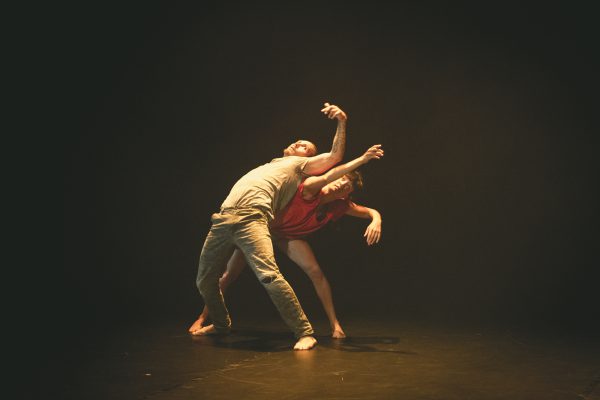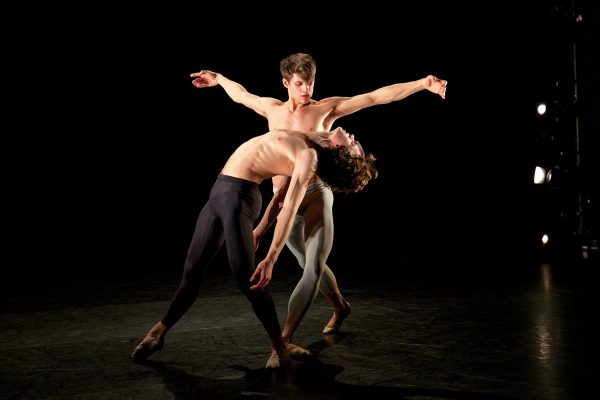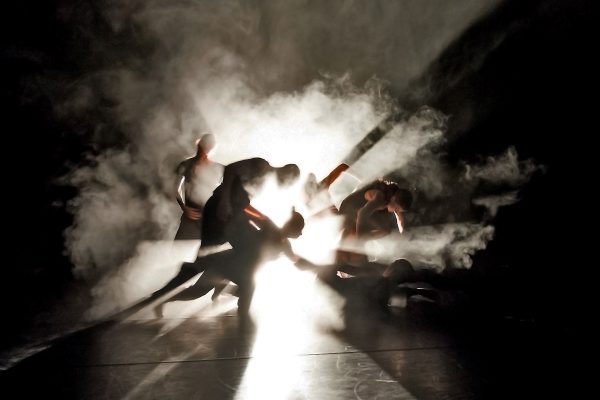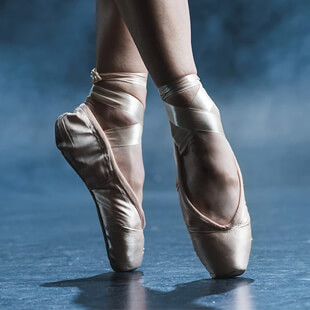Joshua Beamish opened the nineteenth annual ROMP! Festival of Dance, presented by Victoria’s Suddenly Dance Theatre, with a solo show called Lone Wolf on July 8. Made up of three short works, Lone Wolf made clear Beamish’s range as a dancer, but also his major challenge as a performer.
The evening started a little late, and a little humourously. It seemed someone forgot to prop open a fire door at the rear side of the Metro Studio to let Beamish, open umbrella in hand, make his entrance down a short staircase. The hiccup briefly undercut the beginning of the (definitely not humourous) first solo by Ame Henderson, entitled radios.
Everything was deliberately awkward about this piece, from the costume — a grab-bag mix of clothing that included a woman’s black shapeless skirt over a man’s shiny silver boxers — to the movement: close to the ground, with splayed-out feet, arms and shoulders not fully under control. Performed largely to silence or undefined noise until near the end, the fragments of rhythmic music heard then were awkward, too: startlingly upbeat, pushing Beamish into upright rhythmic movement at odds with his earlier jagged crouches. But that fits with the title, radios, and the notion that music, like life itself, can push and pull us in ways we could never expect.
After a quick change to sleek grey pants and socks, Beamish then launched into one of his own pieces, a ballet with a hint of Beyoncé called Concerto. Set to Bach’s Concerto for Violin, Oboe and Strings in D Minor, it showed Beamish, as with radios, in fabulous command of his body, this time displaying solid classical technique. It was easy to see why he has had significant worldwide success choreographing for some of the biggest names in ballet, such as New York City Ballet principal Ashley Bouder and former principal Wendy Whelan. Concerto was both elegant and overtly sexy, fusing classical ballet vocabulary with angular contemporary isolations, with little shivers of pop video come-ons.
That said, while Beamish’s technique and intentions clearly changed with each of the first two pieces, his set face and direct, challenging gaze at the audience did not. His is a compelling presence but, at least within the Metro’s intimate performance space, one that is very hard to like. That close, he demanded too much, all the time: your recognition, your admiration, your desire.
That demand was lessened in the final piece, by means of a black hoodie that hid Beamish’s face. By Noam Gagnon, Fighting Chance was what it sounds like: a man (an everyman, since we don’t see his face) in a metaphorical boxing match, perhaps for his sanity, perhaps for his life. It begins with Beamish under a spotlight just outside a virtual boxing ring, with his back to us, warming up with punches and shuffles. Later, once he’s inside the ring, we come to understand that his is a troubled spirit, maybe a desperate one. The movement alternated between reasonably controlled — fast sit-ups and push-ups, for example — and flailing, agitated, restless, but no movement seemed able to calm the fighter’s soul. Eventually, he returns to the spotlight where he started, to get ready for another round.
The next night brought Present/Tense 10, in which a series of writers read from their work, and dancers, given only the first and last lines before the show, improvised to the sounds, rhythms and meaning of the text. Risky stuff, but a few succeeded brilliantly. Josh Beamish and Walter Kubanek, for instance, scored with Ann-Bernice Thomas’s poem I Didn’t Want to Think of You Tonight. Beat-driven, the poem also provided a narrative, about a relationship one wants more than the other, that the dancers were able to build upon. They created an intimate duet of entwining bodies that also captured the inherent melancholy of lines like “I love the night more than you ever could.”
South Korean Hoyeon Kim also shone with the poem Lemme See You Dance by Janet Rogers. Who wouldn’t want to move to words like “shuffle, shuffle, double buffalo”? In the solo, Kim’s body rose and fell as if boneless with each syncopated beat.
Other dancers struggled with more metaphoric text (Meagan O’Shea’s included the repeated image of a cervix closing, from Fabienne Calvert Fileteau’s What Looks Like a Break Up, What Feels Like the End) and less obviously evocative lines (Kate Franklin got “How do you hunt a jaguar?” from a poem by Charles Tidler), but Andrea Robyn Bayne used fluttering fingers and delicate pointework to elegantly capture Barbara Black’s Advice to Writers Regarding Bees.
Other work presented over the two weekends included Meagan O’Shea’s We Don’t Need Another Hero, a work she premiered in Toronto last year. With different collaborators here in Victoria, the highlight was a trio — the vivid Kate Franklin with Walter Kubanek and Véronique Emmett — forming and reforming relationships, each in a slightly different language: caring, stiff, affectionate and challenging, with wonderful, specific use of fingers, arms and backs.
Suddenly Dance Theatre’s David Ferguson also presented a quartet-in-progress called We are Diamonds, a promising collaboration with three dancers from South Korea. The work is a mix of solos and duets with periods of unified movement that served to propel the piece forward. Diamonds highlighted the slightly distant, acerbic dance style of Hyoseung Ye against the more emotional, fluid grace of Hoyeon Kim. The larger, less intense Ferguson faded somewhat into the background, while the lone female, Min Jin Kim, struggled to find her place: her movement felt too feminine within what was an otherwise genderless piece. This collaboration followed Traces, choreographed and danced by Ye, which explored what it means to be an outsider, lonely, perhaps homeless, in an entirely unsentimental way. Ye did not try to endear himself to the audience but rather deliberately made himself ugly, stuffing a sandwich inside his mouth and then spitting it out, contorting his face, moving arms and legs in near-violent gestures.
Hyoseung Ye, Hoyeon Kim and Min Jin Kim returned to perform in two free shows in Beacon Hill Park July 16 and 17, in a crowd-pleasing, upbeat piece by Ye. However, both evenings belonged to the dancers of Ballet Victoria. In the midst of a series of swift, snappy pieces, perfectly suited to a summer night, the standout was Jacques Lemay’s Le Jazz Hot, which displayed Andrea Robyn Bayne at her flirtiest best.
Tagged: Choreography, Contemporary, Festival, Performance, Walter Kubanek, BC , Victoria





